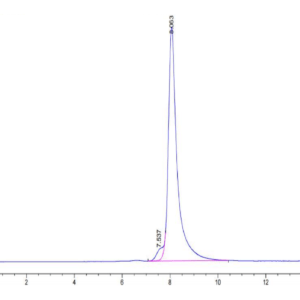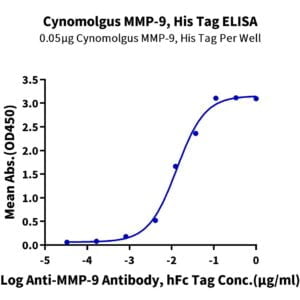| Weight | 1 lbs |
|---|---|
| Dimensions | 9 × 5 × 2 in |
| accession | P21860 |
| express system | HEK293 |
| product tag | C-His-Avi |
| purity | > 95% as determined by Tris-Bis PAGE;> 95% as determined by HPLC |
| background | Her3, also called ErbB3, is a type I membrane glycoprotein that is a member of the ErbB family of tyrosine kinase receptors.Her3 is expressed in keratinocytes, melanocytes, skeletal muscle cells, embryonic myoblasts and Schwann cells. Monomeric Her3 serves as a low affinity receptor for the heregulins (HRG). |
| molecular weight | The protein has a predicted MW of 71.6 kDa. Due to glycosylation, the protein migrates to 90-110 kDa based on Tris-Bis PAGE result. |
| available size | 100 µg, 500 µg |
| endotoxin | Less than 1EU per μg by the LAL method. |
Human Her3/ErbB3 Protein 4483
$180.00 – $600.00
Summary
- Expression: HEK293
- Functional: Yes (ELISA)
- Amino Acid Range: Ser20-Thr643
Human Her3/ErbB3 Protein 4483
| protein |
|---|
| Size and concentration 100, 500µg and lyophilized |
| Form Lyophilized |
| Storage Instructions Valid for 12 months from date of receipt when stored at -80°C. Recommend to aliquot the protein into smaller quantities for optimal storage. Please minimize freeze-thaw cycles. |
| Storage buffer Shipped at ambient temperature. |
| Purity > 95% as determined by Tris-Bis PAGE |
| target relevance |
|---|
| Her3, also called ErbB3, is a type I membrane glycoprotein that is a member of the ErbB family of tyrosine kinase receptors.Her3 is expressed in keratinocytes, melanocytes, skeletal muscle cells, embryonic myoblasts and Schwann cells. Monomeric Her3 serves as a low affinity receptor for the heregulins (HRG). |
| Protein names Receptor tyrosine-protein kinase erbB-3 (EC 2.7.10.1) (Proto-oncogene-like protein c-ErbB-3) (Tyrosine kinase-type cell surface receptor HER3) |
| Protein family Protein kinase superfamily, Tyr protein kinase family, EGF receptor subfamily |
| Mass 148098Da |
| Function Tyrosine-protein kinase that plays an essential role as cell surface receptor for neuregulins. Binds to neuregulin-1 (NRG1) and is activated by it; ligand-binding increases phosphorylation on tyrosine residues and promotes its association with the p85 subunit of phosphatidylinositol 3-kinase (PubMed:20682778). May also be activated by CSPG5 (PubMed:15358134). Involved in the regulation of myeloid cell differentiation (PubMed:27416908). {ECO:0000269|PubMed:15358134, ECO:0000269|PubMed:20682778, ECO:0000269|PubMed:27416908}. |
| Catalytic activity CATALYTIC ACTIVITY: Reaction=ATP + L-tyrosyl-[protein] = ADP + H(+) + O-phospho-L-tyrosyl-[protein]; Xref=Rhea:RHEA:10596, Rhea:RHEA-COMP:10136, Rhea:RHEA-COMP:10137, ChEBI:CHEBI:15378, ChEBI:CHEBI:30616, ChEBI:CHEBI:46858, ChEBI:CHEBI:82620, ChEBI:CHEBI:456216; EC=2.7.10.1; Evidence={ECO:0000269|PubMed:20351256}; |
| Subellular location [Isoform 1]: Cell membrane {ECO:0000269|PubMed:33497358}; Single-pass type I membrane protein.; [Isoform 2]: Secreted. |
| Tissues Epithelial tissues and brain. |
| Structure Monomer and homodimer. Heterodimer with each of the other ERBB receptors (Potential). Interacts with CSPG5 (PubMed:15358134). Interacts with GRB7 (PubMed:9516479). Interacts with MUC1 (PubMed:12939402). Interacts with MYOC (By similarity). Interacts with isoform 2 of PA2G4 (PubMed:11325528, PubMed:16832058). Found in a ternary complex with NRG1 and ITGAV:ITGB3 or ITGA6:ITGB4 (PubMed:20682778). {ECO:0000250|UniProtKB:Q61526, ECO:0000269|PubMed:11325528, ECO:0000269|PubMed:12939402, ECO:0000269|PubMed:15358134, ECO:0000269|PubMed:16832058, ECO:0000269|PubMed:20682778, ECO:0000269|PubMed:9516479, ECO:0000305}. |
| Post-translational modification Autophosphorylated (PubMed:20351256). Ligand-binding increases phosphorylation on tyrosine residues and promotes its association with the p85 subunit of phosphatidylinositol 3-kinase (PubMed:20682778). {ECO:0000269|PubMed:20351256, ECO:0000269|PubMed:20682778, ECO:0000269|PubMed:33497358}. |
| Domain The cytoplasmic part of the receptor may interact with the SH2 or SH3 domains of many signal |
| Target Relevance information above includes information from UniProt accession: P21860 |
| The UniProt Consortium |
Data
Publications
Publications
| pmid | title | authors | citation |
|---|---|---|---|
| We haven't added any publications to our database yet. | |||
Protocols
| relevant to this product |
|---|
Documents
| # | ||
|---|---|---|
| Please enter your product and batch number here to retrieve product datasheet, SDS, and QC information. | ||


















